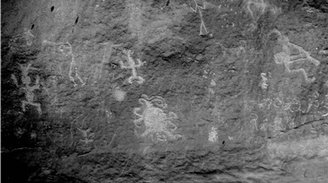撰文\播音:埃米莉·施温(Emily Schwing)
翻译:张朵儿
审校:潘磊
More than 900 years ago, the Pueblo people were thriving in New Mexico’s Chaco Canyon. While they were there, the region experienced what the whole country is looking forward to on August 21st: a total solar eclipse. Theirs took place in the year 1097—and they may have left a record of the event.
九百多年前,普韦布洛人在新墨西哥州的查科峡谷繁衍生息。在他们生活期间,这个地区经历了一场日全食,和这次全国都期待着8月21日的日食一样。他们的发生在1097年-而且很有可能留下了相关记录。
“I spotted this very peculiar petroglyph, which was a round object.”
“我发现了这幅非常奇特的岩画,画面是一个圆形的物体。”
Kim Malville is a retired Solar Astronomer from the University of Colorado Boulder. In 1992, he and colleagues were leading a field course in Chaco Canyon when he noticed a unique carving on the south side of a rock.
Kim Malville是科罗拉多大学博尔德分校的太阳天文学家,目前已经退休。1992年,他和他的同事们在参与一项野外课程的时候,注意到岩石南部有一个独特的雕刻画。
“…which was a round object with loops coming out of it, and it struck me as maybe this was an image of the sun with the corona in a very active state. And maybe at that time, there is what is known as a coronal mass ejection.”
“…岩画描述了一个圆形的物体,有圆环从里面出来的过程。令我震惊的是:这可能是日冕处于活跃状态时的太阳图景。也许在那个时候发生了所谓的日冕物质抛射。”
That’s when a giant cloud of plasma spirals off the sun’s surface because of a solar flare. “It was somewhat foolhardy I suppose, on our part to suggest a particular explanation for it.” But Malville knew that he had a testable hypothesis.
由于太阳耀斑活动,一道巨大的等离子体云从太阳表面旋转冲出。“我想,只凭我们要对这个现象给出一个特别的解释,是有些不量力的。”但是,马尔维尔知道,他有一个可尝试的假设。
Astronomers knew that the region had a total solar eclipse on July 11, 1097. During the brief darkness, the sun’s corona would have been visible. Solar activity increases and decreases on a roughly 11-year cycle, so Malville used various historic records to find out what was happening in 1097.
天文学家知道这片地区在1097年7月11日发生了一次日全食。在短暂的黑暗中,日冕是可见的。太阳活动涨落大概以11年为周期,所以马尔维尔通过各种历史记录来推测1097年发生了什么。
“And all of these indicated that in 1097, the sun was indeed in a state of very high activity and thus, we couldn’t prove that this was actually an image of the corona, but we could not falsify our hypothesis.” [José M. Vaquero and J. McKim Malville, On the Solar Corona Petroglyph in the Chaco Canyon, in Mediterranean Archaeology and Archaeometry, 2014]
“所有这些资料都表明,在1097年,太阳确实处于一个活跃状态。我们还不能证明这个形象就是日冕,但是这也不能否定我们的假设。”
In another portion of Chaco Canyon, a pictograph high on an overhang has been interpreted as marking a supernova explosion in 1054. Below that, a pictograph may mark the sighting of Hailey’s Comet in 1066.
在查科峡谷的另一片地区,一处被刻在高处的象形文字已经破译,它记录1054年的超新星爆发。在那处文字的下面,也发现了有可能属于1066年海莉彗星出现时的记录。
“And all three of them may have played a role in intensifying people’s interest in the heavens and looking at the heavens very carefully.”
“这三个天文事件增强了那时人们对天空的兴趣,他们会仔细观察天空。”
Which is exactly what millions of current residents will be doing during this summer’s solar eclipse over North America.
这也正是今夏北美日食期间,数百万居民正在做的事情。

 京公网安备11010502039775号
京公网安备11010502039775号  京公网安备11010502039775号
京公网安备11010502039775号 
















